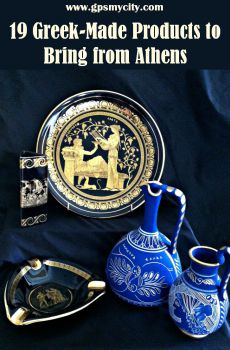National Archaeological Museum, Athens (must see)
With an extraordinary exhibits that include stunning Mycenaean gold and an unparalleled quantity of sculpture, pottery, and jewelry, this museum stands as one of the world's most remarkable. Originally opened in 1891, it consolidated a collection that had been scattered throughout the city, only to be dispersed again and buried during World War II to protect it from potential damage. The museum reopened in 1946, but it took an additional 65 years of renovation and reorganization to truly showcase its treasures.
The ground floor features Mycenaean, Neolithic, and Cycladic artifacts, followed by Geometric, Archaic, Classical, Roman, and Hellenistic sculpture. You'll also find Egyptian artifacts, a significant jewelry collection, and the Karapános collection on this level. Meanwhile, the first floor houses pottery, glassware, jewelry, and items from ancient Thera (on Santorini).
Highlights include a gold death mask discovered at Mycenae by Heinrich Schliemann, initially believed to have belonged to the legendary king Agamemnon, dating from the mid-1600s BC. The immense 'Dípylon Amphora', a geometric vase found in the Kerameikos cemetery, was used to mark the burial of an 8th-century BC woman and depicts the deceased surrounded by mourning women. Cycladic sculpture, such as the 'Harp Player', flourished in the 3rd millennium BC; its simple lines and bold forms influenced many early 20th-century artists, including the British sculptor Henry Moore. The 'Ephebe of Antikythera' is a splendid Hellenistic bronze statue discovered in 1900; standing at around 2 meters (7 feet) tall, it is larger than life. Another notable piece is a marble sculpture of Aphrodite, Eros, and the goat-footed Pan, dating from around 100 BC.
The museum's building has a neoclassical design and features an adjacent neoclassical-style garden studded with many ancient statues. There is also a café and a gift shop that sells reproductions of many of the objects displayed inside.
Why You Should Visit:
While not entirely off the beaten path, this place tends to have fewer tourists compared to other central locations, making it easier to examine the impressive exhibits and read the informational descriptions. If needed, you can also request an English-speaking guide for an even deeper understanding of the history behind the artifacts.
Tip:
Visit during the heat of the day to enjoy the air-conditioning, and don't forget your camera – photography is allowed.
The ground floor features Mycenaean, Neolithic, and Cycladic artifacts, followed by Geometric, Archaic, Classical, Roman, and Hellenistic sculpture. You'll also find Egyptian artifacts, a significant jewelry collection, and the Karapános collection on this level. Meanwhile, the first floor houses pottery, glassware, jewelry, and items from ancient Thera (on Santorini).
Highlights include a gold death mask discovered at Mycenae by Heinrich Schliemann, initially believed to have belonged to the legendary king Agamemnon, dating from the mid-1600s BC. The immense 'Dípylon Amphora', a geometric vase found in the Kerameikos cemetery, was used to mark the burial of an 8th-century BC woman and depicts the deceased surrounded by mourning women. Cycladic sculpture, such as the 'Harp Player', flourished in the 3rd millennium BC; its simple lines and bold forms influenced many early 20th-century artists, including the British sculptor Henry Moore. The 'Ephebe of Antikythera' is a splendid Hellenistic bronze statue discovered in 1900; standing at around 2 meters (7 feet) tall, it is larger than life. Another notable piece is a marble sculpture of Aphrodite, Eros, and the goat-footed Pan, dating from around 100 BC.
The museum's building has a neoclassical design and features an adjacent neoclassical-style garden studded with many ancient statues. There is also a café and a gift shop that sells reproductions of many of the objects displayed inside.
Why You Should Visit:
While not entirely off the beaten path, this place tends to have fewer tourists compared to other central locations, making it easier to examine the impressive exhibits and read the informational descriptions. If needed, you can also request an English-speaking guide for an even deeper understanding of the history behind the artifacts.
Tip:
Visit during the heat of the day to enjoy the air-conditioning, and don't forget your camera – photography is allowed.
Want to visit this sight? Check out these Self-Guided Walking Tours in Athens. Alternatively, you can download the mobile app "GPSmyCity: Walks in 1K+ Cities" from Apple App Store or Google Play Store. The app turns your mobile device to a personal tour guide and it works offline, so no data plan is needed when traveling abroad.
National Archaeological Museum on Map
Sight Name: National Archaeological Museum
Sight Location: Athens, Greece (See walking tours in Athens)
Sight Type: Museum/Gallery
Sight Location: Athens, Greece (See walking tours in Athens)
Sight Type: Museum/Gallery
Walking Tours in Athens, Greece
Create Your Own Walk in Athens
Creating your own self-guided walk in Athens is easy and fun. Choose the city attractions that you want to see and a walk route map will be created just for you. You can even set your hotel as the start point of the walk.
Plaka Attractions Walking Tour
Plaka, the oldest-and in many views, the most photogenic-district of Athens is where history isn’t just studied, it’s lived. Nestled at the foot of the mighty Acropolis, this is the "neighborhood of the Gods"-which sounds dramatic, but when you see it, you’ll understand why.
People have settled here since antiquity, so don’t be surprised if the walls seem to whisper ancient... view more
Tour Duration: 2 Hour(s)
Travel Distance: 3.6 Km or 2.2 Miles
People have settled here since antiquity, so don’t be surprised if the walls seem to whisper ancient... view more
Tour Duration: 2 Hour(s)
Travel Distance: 3.6 Km or 2.2 Miles
Athens Food Walking Tour
Traditional Greek cuisine is one of the healthiest in the world, and prices in all but the flashiest establishments afford excellent value. The prevalence of vegetable and dairy dishes makes eating out a delight for non-meat eaters. Carefully selected appetizers (tzatzíki, dolmádes, kalamarákia) can constitute a full meal. Greece’s most famous slow-cooked oven dish, however, is probably... view more
Tour Duration: 1 Hour(s)
Travel Distance: 2.2 Km or 1.4 Miles
Tour Duration: 1 Hour(s)
Travel Distance: 2.2 Km or 1.4 Miles
Walking Around the National Garden
The National Garden is an impressive, historic park in the center of Athens, complete with artificial streams and duck ponds. Formerly known as the Royal Garden, it was commissioned by King Otto’s queen, Amalia, in 1838, reason why it is located directly behind the Old Palace (currently the Greek Parliament building). Not only is it a welcome refuge from the swirl of traffic just outside the... view more
Tour Duration: 2 Hour(s)
Travel Distance: 3.3 Km or 2.1 Miles
Tour Duration: 2 Hour(s)
Travel Distance: 3.3 Km or 2.1 Miles
Athens Introduction Walking Tour
Athens, the cradle of Western Civilization and one of Europe's oldest cities, originated between the 4th and the 3rd millennia BC. The story of Athens stems from a mythological contest between the goddess of wisdom and warfare, Athena, and the god of the sea, Poseidon. Both deities vied to become the city's patron. Poseidon's gift of a saltwater spring was deemed impractical,... view more
Tour Duration: 3 Hour(s)
Travel Distance: 4.2 Km or 2.6 Miles
Tour Duration: 3 Hour(s)
Travel Distance: 4.2 Km or 2.6 Miles
Walking Tour Around the Legendary Acropolis
Ah, the Acropolis of Athens-also known as "the sacred rock," because apparently, even rocks can have VIP status. This iconic hill has been home to temples, sanctuaries, and centuries of drama (both the theatrical and the historical kind). The ancient Greeks held this place in such high regard that they built architectural marvels that still dominate the city’s skyline. You can spot the... view more
Tour Duration: 1 Hour(s)
Travel Distance: 1.0 Km or 0.6 Miles
Tour Duration: 1 Hour(s)
Travel Distance: 1.0 Km or 0.6 Miles
Useful Travel Guides for Planning Your Trip
A Self-Guided Food Walk in Athens
Just as many things in Greece, dining in Athens is very much laid-back with the majority of local eateries seeing patrons begin to congregate for dinner only after 8 pm. Eating-wise, the Athenians favor simplicity, leaning to the more casual and not so pricey tavernas where food is plentiful. To...
Souvenirs Shopping: 19 Uniquely Greek Products to Bring from Athens
A cradle of European civilization, Greece, in general, and Athens, in particular, have long been - from the days of the Roman Empire up until present - the lure for travelers and history buffs seeking to find and bring home something memorable. Today's Athens (much as its ancient self) offers a...
14 Best Cafes in Athens
While in Athens it is immediately noticeable that the local cafe culture thriving. Through this directory you will get a chance to visit very different establishments, ranging from "kafenia", to hip, modern coffee shops and get first hand experience of the diversity of contemporary Greek...











